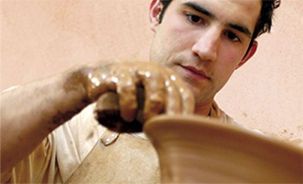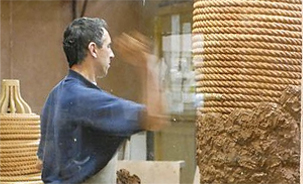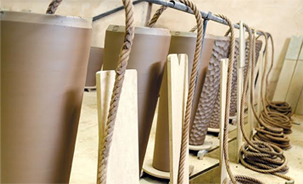MANUFACTURE TECHNIQUES
Poterie Goicoechea's staff are proud of their craft and its Basque traditions.
 |
JIGGERING AND STAMPING Jiggering is used to manufacture round pots of all sizes. The clay is shaped by the centrifugal force of the jigger. The rotation of the jigger forces the clay up the walls of the mould. Smaller pots are then removed immediately from the mould whereas larger pots are left to dry and harden over 24 hours before being removed. Stamping involves applying the clay manually within a mould to give it a specific shape. We use this method for square and rectangular pottery. |
 |
HAND THROWING Hand throwing technique allows us in particular to launch new collection without having to go through the long stage of producing moulds. For the same parts and the same rating, the turner always uses the same weight blanks and meets specific benchmarks. This majestic process that requires complete mastery of gestures and many years of training, is often considered an art in itself. It usually takes 10 years of practice to make a seasoned turner. |
 |
THE ROPE TECHNIQUE This is our most dramatic production technique, the ancestral knowledge is preciously transmitted within the company. It concerns only the pots very large.Our technique is to replace the mould with a wood and rope frame onto which the clay is applied. This structure must be removable as would an external mold. The rope structure is first positioned on a clay base which will form the bottom of the pot. The clay is then applied. This technique involves throwing hand handfuls of moist clay to cover all of the rope structure. The surface of the pot is smoothed by an external template as the pot revolves. Once shaped, the frame is removed from the piece in the drying room. Generally it takes for between 1 and 3 days for the clay to be hard enough to extract the rope. |
 |
DRYING Before moving to the oven, the pieces are stored in a drying zone and kept in specific environmental conditions. Drying is a delicate stage of manufacture where all the work previously done can be wiped out by a single crack. Cracks occur as a result of mechanical stresses on the clay as the moisture it contains evaporates ( up to 10% of withdrawal). Three factors must be controlled in order to create and ideal environment for drying: ventilation, temperature and humidity. Fans ensure continuous air circulation around the pots. Outward vents, used to manage the temperature and humidity by drawing in naturally cool and damp air from outside... The ambient temperature is controlled by an ingenious heating system, powered by the heat of the kilns of the factory. |
 |
GLAZING The enamel is a glass consisting essentially silica, feldspar, kaolin and metal oxides. This mixture is vitrified at high temperatures during the second firing process. Obtaining the enamel powder involves the merging various components at very high temperatures (1000 ° C) to obtain the enamel powder ready for use. This is a key step, it is meticulous and costly. The powder is applied using an airbrush on previously cooked pieces (called biscuit). The powder must be applied as a uniform layer and at a certain thickness. Once covered with this mixture, the pots have a matt appearance bearing no resemblance to the finished article. The magic of vitrification is in the revelation of the true color and the beauty of enamel. Glazed biscuit is put again in the oven. The temperature of the kiln varies according to the colour and the desired finish, anywhere from 940 to 980 °C over a period of 2 to 3 days. |
 |
FIRING Goicoechea has 3 high tech kilns powered by gas. These are “bell” ovens operated by hoists which are positioned above the pieces to be fired.The loading of the kilns must be carefully planned so that heat circulates evenly around each piece. Firing is one of the most expensive parts of the production process and so each kiln has to be maximised. With a capacity of 22 cubic metres a kiln can take up to 40 large pieces and 300 small pieces in a single load. The rise in temperature is done progressively over 40 hours before reaching 1030 ° C and is then gradually decreased for 20 hours before returning to room temperature. The process of firing induces a chemical reaction that transforms the clay into a durable material in near rocklike state. |
